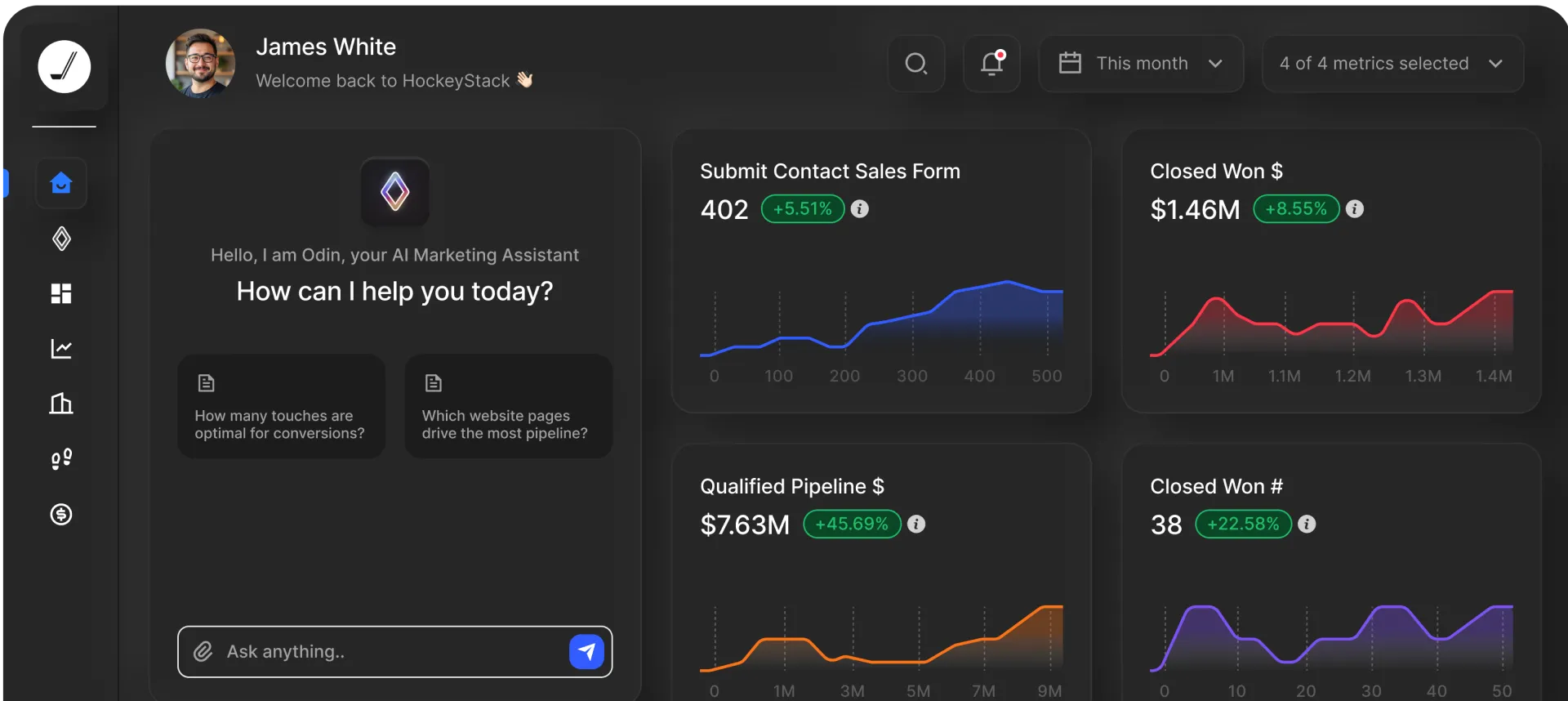Lead Attribution: What is It and Why it Should Be a Priority for Your Business

Lead Attribution: What is It and Why it Should Be a Priority for Your Business

Picture this: your biggest deal of the year just closed. The sales team is taking a victory lap. The CRM, in its infinite wisdom, attributes the win to "Direct Traffic." But you know the real story. You know that before that final click, this account saw a dozen LinkedIn ads, the CTO attended a webinar, and their junior analyst downloaded three of your eBooks.
In a world where over 60% of marketers cite measuring ROI as their top challenge [*], mastering attribution is the difference between being a data-driven growth engine and a perceived cost center. It's how you justify your budget, optimize your spend, and stop sales from getting all the credit.
This guide breaks down the different attribution models and shows you how to finally answer the question: What's actually working?

What is Lead Attribution, Really?
Let's cut through the jargon. Lead attribution is the framework for figuring out which of your marketing efforts actually convinced someone to become a lead and, eventually, a customer. It’s the process of assigning credit to the different touchpoints a person interacts with on their path to conversion.
While some people draw a fine line between lead attribution (creating a lead) and marketing attribution (creating a sale), it's a distinction that doesn't matter in the real world. A lead has no value if it doesn't turn into revenue. The goal is always to understand the entire journey from the first touch to the final sale.
To see why this is so complex, let's ditch the simple textbook examples and look at how a real B2B deal happens. The modern B2B buying journey isn't a straight line; it's a chaotic web of interactions. Research from Gartner shows that B2B buyers can engage with a provider through more than 10 channels while doing their research. [*]
To make this tangible, let's create a realistic buyer persona and follow her journey from start to finish. We'll call her Anna, a VP of Operations at a mid-sized tech company. We will use her story throughout this guide to test each attribution model.
Here is Anna's path to becoming a customer:
- 3 months ago: Anna sees one of your ads on LinkedIn during her lunch break. She doesn’t click, but the name sticks.
- 2 months ago: She Googles a problem she's having, finds one of your blog posts, and reads it.
- 1 months ago: She gets retargeted with an ad for your upcoming webinar, signs up, and attends.
- Today: She finally types your website address directly into her browser and books a demo.
So, who gets the credit? Is it the first ad she saw? The blog post that solved her problem? The webinar that got her email address? Or the final click that led to the demo request?
Answering this question is the entire point of lead attribution. The model you choose determines how you assign credit, and that decision-making directly impacts how you'll invest your time and budget moving forward.
Why a Clear Attribution Strategy Is a Mission-Critical Priority
So, we've established that the B2B buyer's journey is a chaotic, multi-touch web. Without a way to make sense of that chaos, you're not just flying blind—you're making expensive decisions based on guesswork. Proper lead attribution is the framework that turns that chaos into clarity.
Here are the real, high-stakes reasons why it should be a top priority for your business.
It Stops You from Wasting Your Budget
Every marketing leader knows that some of their budget is wasted; the terrifying part is not knowing how much or where. An unattributed marketing budget is a leaky bucket. You keep pouring money in, but you can't see which holes are losing you the most cash.
Lead attribution plugs those leaks. By connecting your spending to actual outcomes, you can finally see which channels and campaigns are driving real profitability and which are just vanity metrics. For example, you might discover that your expensive PPC campaign has a high cost-per-lead but low close rates, while your organic content is sourcing your most valuable customers.
According to Nielsen, marketers who implement robust attribution see an average 15-30% improvement in marketing efficiency. That's money you can re-invest in the channels you know are working. [*]
It Proves Your Team's Value to the Business
Marketing is often treated as a cost center because it struggles to prove its direct impact on revenue. When a deal closes, the final touchpoint (like a demo request) gets all the credit, while the months of work that warmed up the account—the blog posts, the social media engagement, the webinar attendance—get ignored.
Lead attribution is the evidence you bring to the budget meeting. It allows you to move the conversation from "We generated 1,000 leads" to "Our content marketing efforts influenced $2 million in pipeline last quarter." By showing exactly how your digital marketing efforts guide a high-value customer from awareness to purchase, you prove that your team isn't a cost center; it's the primary engine for growth.
It Creates a Smarter Customer Experience
Knowing which channels bring you leads is one thing. Knowing the specific content journey of each lead is a competitive advantage. When you can see the articles, ads, and landing pages a prospect engaged with before converting, you get a powerful glimpse into their needs and intent.
This data allows you to create a more relevant and effective customer experience.
- For marketing: If you know leads who convert best have all read your articles on a specific topic, you can create more content around that topic and use it to nurture other qualified leads.
- For sales: If a salesperson sees a lead engaged with three case studies about your features, they can tailor their demo to solve that exact pain point, dramatically increasing the chances of closing the deal. This level of personalization is proven to work—80% of consumers are more likely to make a purchase from a brand that provides personalized experiences. [*]
Attribution doesn't just help you look back at what worked; it helps you build a smarter, more personalized path forward for every future customer.
The Good, The Bad, and The Ugly of Lead Attribution Models
At its core, every attribution model falls into one of two camps: single-touch or multi-touch.
- Single-touch attribution models: This philosophy gives 100% of the credit for a conversion to a single event. It’s simple, clean, and in most B2B use cases, dangerously wrong. It’s like judging a five-season TV series by only watching the first or last episode.
- Multi-touch attribution models: This approach acknowledges that the B2B customer journey is complex and splits the credit across multiple touchpoints. It’s more realistic, more complex, and the only way to get a true picture of what’s driving growth.
Let's break down the most common models within these two camps. We'll apply each one to Anna's journey to see how they assign credit and where their strengths and weaknesses lie.
As a reminder, here are the five key touchpoints we'll analyze in Anna's journey from awareness to a closed deal:
- LinkedIn ad (First touch/awareness)
- Webinar (Lead conversion)
- Blog post (Mid-funnel nurturing)
- Sales demo (Opportunity creation)
- Contract signed (Deal closed/final conversion)
First-Touch Attribution
The guiding philosophy of first-touch attribution is that the very first interaction is the most important. This model champions the top of the funnel, operating on the belief that without that initial point of brand awareness, none of the subsequent interactions would have happened. It is designed to reward the marketing channels and activities that are responsible for creating original demand.
- How Anna's deal gets credit: The LinkedIn ad that she first saw months ago gets 100% of the credit for the entire deal value.
- The honest truth: This model is great for understanding what initially creates demand. However, it completely ignores everything that happens afterward—the webinar, the blog posts, and the sales demo that actually convinced Anna to buy.
Last-Touch Attribution
This model operates on the opposite belief: the last touchpoint before a conversion is the only one that matters. Its logic is that this last action is what ultimately triggered the desired outcome. This is the default model in most CRMs like Salesforce, primarily because it's the easiest to track. It gives full credit to the last interaction that occurred just before a lead or deal was created.
- How Anna's deal gets credit: The sales demo gets 100% of the credit, as it was the last major interaction before the contract was signed.
- The honest truth: This model is misleading. It systematically devalues all the crucial mid-funnel marketing that educates and nurtures leads, making your content and demand gen efforts look worthless. Relying solely on this model is one of the most common and costly mistakes in marketing analytics.
Linear Attribution
The linear model takes a more democratic approach to attribution. It acknowledges that the journey is complex and operates on the assumption that every interaction plays an equal and supportive role in moving the prospect forward. It doesn't try to weigh one touchpoint over another; instead, it gives each one equal credit.
- How Anna's deal gets credit: The LinkedIn ad, webinar, blog posts, and sales demo each get an equal 25% share of the credit for the final conversion.
- The honest truth: This is a huge step up from single-touch because it acknowledges that multiple customer interactions matter. However, its core assumption is flawed—was seeing a LinkedIn ad really as valuable as attending an hour-long webinar and getting a personalized demo? Probably not.
Time-Decay Attribution
The time-decay model introduces the concept of momentum. Its philosophy is that sales and marketing touchpoints gain importance as a prospect gets closer to converting. The actions taken just before the sale are seen as the most influential in pushing the deal over the finish line, while earlier touchpoints are given less credit for having a more passive, foundational role.
- How Anna's deal gets credit: The sales demo would get the most credit (e.g., 40%), the blog posts would get less (e.g., 30%), the webinar even less (e.g., 20%), and the initial LinkedIn ad would get the least (e.g., 10%).
- The honest truth: This model improves on linear attribution by introducing nuance, and it accurately values the final stages of consideration. However, it can still significantly undervalue critical top-of-funnel marketing activities that introduce your brand and make the entire journey possible.
U-Shaped (or Position-Based) Attribution
The U-Shaped model provides a more balanced multi-touch view by focusing on two pivotal moments in the journey: the "first hello" and the "first handshake." It gives the majority of the credit to the very first touchpoint that created awareness and the touchpoint that officially converted the prospect into a lead. It argues that these are the two most critical milestones.
- How Anna's deal gets credit: The first touch (LinkedIn ad) and the lead conversion touch (webinar) would each get 40% of the credit. The touchpoints in between (blog posts) would split the remaining 20%.
- The honest truth: This is one of the most popular and respected multi-touch models for B2B marketers. It rightly values both initial demand creation and the critical mid-funnel conversion point, making it a solid and reliable choice for many organizations.
W-Shaped Attribution
This model evolves directly from the U-shaped attribution approach. It argues that for B2B sales, there is a third critical milestone that deserves significant credit: the moment a lead becomes a qualified sales opportunity. This is a crucial point in the journey where marketing hands a ready-to-engage prospect over to the sales team. The W-shaped model, therefore, gives heavy credit to the first touch, the lead conversion touch, AND the opportunity creation touch.
- How Anna's deal gets credit: The first touch (LinkedIn Ad), lead conversion (webinar), and opportunity creation (sales demo) would each get 30% of the credit. The nurturing touchpoints in between (blog posts) would get the remaining 10%.
- The honest truth: For businesses with a distinct MQL-to-SQL process, this model provides an even more accurate view than the U-shaped model. It properly values the marketing efforts that not only create a lead but also generate a qualified opportunity for the sales team.
Custom & Algorithmic Attribution
This is the holy grail of marketing attribution. Instead of relying on any predefined rules, a custom algorithmic model uses machine learning to analyze all of your historical sales data. It compares thousands of won and lost deals to discover the actual statistical impact of every single touchpoint, from ad campaigns to content assets. It then builds a completely custom model that is unique to your business, your sales cycle, and your prospect’s behavior.
- How Anna's deal gets credit: The AI would assign credit based on its findings. For instance, it might analyze all past deals and determine that for customers like Anna, the webinar is by far the most influential touchpoint, assigning it 55% of the credit, while distributing the rest based on its data-driven conclusions.
- The honest truth: This is, without question, the most accurate attribution model possible. Its only downside is that you absolutely cannot do this in a spreadsheet. It requires a powerful and unified analytics platform, like HockeyStack, that can process all of your GTM data in one place.
The 3 Key Challenges of Lead Attribution
While the concept of lead attribution is straightforward, putting it into practice is where most companies get stuck. It’s not as simple as picking a model and flipping a switch. The reality is that getting accurate, actionable attribution is incredibly difficult.
If you've struggled with this, you're not alone. The vast majority of companies face the same three fundamental challenges.
1. Your Information Lives in Silos
Your data is scattered across a dozen different platforms that don't talk to each other. Your web visits are in Google Analytics, your ad clicks are in Google and LinkedIn Ads, your webinar sign-ups are in your marketing automation tool, and your deal information is in Salesforce.
This is known as the data silo problem. According to Forrester, one of the top challenges for marketers is the struggle to unify and integrate this fragmented data. [*] Without a single source of truth, it's impossible to connect the dots and see the full customer journey. You're left trying to piece together a puzzle with pieces from ten different boxes, and you'll never get the complete picture.
2. The Customer Journey Isn't a Straight Line
The B2B buying process is long, complex, and involves a whole team of people. Remember Anna? She wasn't acting alone. The average B2B buying committee now involves 6 to 10 decision-makers, each with their own research, interactions, and dark funnel activities (like listening to podcasts or talking with peers). [*]
How do you account for all of that? How do you track the influence of an anonymous LinkedIn post someone shared with the buying committee, or a key feature that was discussed on a sales call? Traditional attribution struggles to capture this messy middle, meaning you're only ever seeing a small, incomplete fraction of the real behavior that leads to a sale.
3. Turning Insights into Action
Even if you manage to unify your data and pick a model, you face the final and most difficult challenge: actually using the information. An attribution report sitting in a folder is useless.
The goal is to operationalize your insights, but this presents two problems:
- Analysis paralysis: With so many models and so much data, many teams get stuck in endless debate about which model is right and never make a decision.
- Lack of trust and adoption: Often, the sales team doesn't trust the marketing data, or the marketing team doesn't have a way to easily act on the insights. Without a system that makes attribution data accessible and actionable for the entire GTM team, your reports will never translate into smarter decisions and improved marketing strategy.
How to Actually Get Started with Lead Attribution
Alright, so you're convinced. You know attribution is critical, but the path from knowing to doing feels like a minefield. Where do you even begin?
Here is a realistic, no-nonsense playbook for implementing lead attribution without getting stuck in analysis paralysis for six months.
Step 1: Tame the Data Chaos
This is the hardest part, but it's non-negotiable. You cannot do attribution if your data lives in separate systems that refuse to speak to each other. Your first job is to connect your tech stack and create a single source of truth. Otherwise, you're just decorating a house that has a broken foundation.
- How to get started: Connect the dots. Use a platform that integrates your CRM (like Salesforce), your ad platforms (LinkedIn, Google), your website analytics, and your marketing automation tools. The goal is to see the entire customer journey in one place.
- The payoff: This ends the finger-pointing. No more "marketing's numbers don't match sales' numbers." You get one unified view of the truth, which is the necessary foundation for everything else.
Step 2: Define What Winning Actually Looks Like
Too many teams only track the final conversion—the signed contract. But in a long B2B sales cycle, that's like saying the only part of a football game that matters is the final whistle. You need to define the key touchdowns along the way.
- How to get started: Map out the critical milestones of your actual customer journey. Don't use a generic template. Sit down with sales and define your key events. For most B2B teams, this includes:
- First touch: The moment of creation for brand awareness.
- Lead creation: The first time you get an email address (e.g., webinar signup).
- Opportunity creation: The moment sales accepts the lead and opens a real opportunity.
- Closed won: The deal is signed.
- The payoff: This allows you to measure marketing's impact on the entire sales funnel, not just the final play. You can finally show how your efforts created not just quality leads, but qualified sales opportunities.
Step 3: Pick a Model and Escape Analysis Paralysis
This is where great intentions go to die. Teams spend months in meetings endlessly debating the philosophical differences between a time-decay and a U-shaped model. It's the perfect recipe for doing nothing at all.
- How to get started: Just start. Pick a balanced, respected multi-touch model like U-shaped or W-shaped and commit to it for one quarter. It will not be perfect, but it will be a universe ahead of the deeply flawed last-touch model that your CRM currently uses as its default.
- The payoff: You immediately get a more realistic baseline for performance. You'll start seeing which channels create demand versus which ones close deals. This initial clarity is far more valuable than waiting for a perfect model that doesn't exist.
Step 4: Ask Brutal Questions and Act on the Answers
The final step is to use your new superpower. An attribution model isn't just for creating reports; it's for interrogating your marketing strategy and making tough, data-backed decisions.
- How to get started: Start asking the hard questions you couldn't answer before:
- "Which blog posts are influencing our enterprise deals?"
- "Is our expensive trade show sponsorship actually creating pipeline, or is it just creating brand awareness?"
- "Which ad campaign is great at generating cheap leads that never close?"
- The payoff: This is where the ROI lives. The answers to these questions allow you to act with confidence. You can shift budget from underperforming channels, double down on the content that works, and give your sales team the insights they need to have more relevant conversations.
How to Choose an Attribution Software (and Avoid Expensive Mistakes)
The attribution tool you choose is a high-stakes decision. The right platform can transform your GTM engine into a data-driven powerhouse. The wrong one will just give you another pretty dashboard with the same siloed, untrustworthy data you already have.
The market is flooded with options, from basic reporting add-ons to true GTM intelligence platforms. To tell the difference, you need to look beyond the sales pitch and evaluate tools based on a few non-negotiable criteria.
Here’s what to look for.
Seamless, No-Code Data Unification
This is the absolute foundation. If a tool can't easily and reliably connect to all the platforms you use, it's useless. Don't settle for a handful of basic integrations; look for a platform built to be the central hub for your entire stack.
- What to look for:
- Deep, native integrations with your CRM (Salesforce, HubSpot), ad platforms (Google, LinkedIn, Facebook), marketing automation tools, and data warehouses.
- A simple, no-code setup that doesn't require weeks of engineering resources to get running.
- The ability to stitch together the entire journey, from the first anonymous website visit to the final closed-won deal, unifying all your customer data.
Support for Advanced, Flexible Attribution Models
Many attribution tools only offer the same basic, rule-based models (first-touch, last-touch, linear) that we've already shown are flawed. A modern platform shouldn't limit you; it should empower you with more accurate and flexible modeling options.
- What to look for:
- Full support for all major multi-touch models, including U-shaped and W-shaped, allowing you to choose the model that best fits your business logic.
- The option for AI-driven, algorithmic modeling. This is the gold standard. A platform that can analyze your historical data to build a custom model for your business will always be more accurate than one using simple, predefined rules.
AI-Powered Insights, Not Just Reports
A dashboard can show you what happened, but it rarely tells you why. The best tools don't just visualize your data; they analyze it for you. They move beyond simple reporting to provide actual intelligence.
- What to look for:
- An AI engine that acts like a data analyst. Can you ask it plain-English questions about your performance (e.g., "Which marketing campaign had the best return on investment (ROI) last quarter?") and get an instant answer with charts and visualizations?
- Proactive insights and recommendations. Does the tool automatically surface opportunities, like identifying an underperforming channel where you're wasting money or a high-performing campaign you should double down on?
Features That Turn Insights into Action
An attribution report that just gets emailed around is a waste of time. The entire point is to drive smarter decision-making and automate GTM execution. A top-tier platform must have features that close the loop between data and action.
- What to look for:
- The ability to create automated workflows. For example, can the tool automatically add high-intent accounts to a specific ad campaign or alert a sales rep in Slack when their target account visits the pricing page?
- Actionable data for the entire GTM team. The platform should provide insights not just for marketers, but also for sales reps (e.g., which talking points to use based on a lead's content journey) and leadership (e.g., reliable pipeline forecasting).
Choosing a tool with these four pillars in mind ensures you're investing not just in a new dashboard, but in a command center for your entire GTM team.
Why HockeyStack Is Built for Modern Attribution
Finding a tool that checks all four of those boxes—unification, advanced modeling, AI insights, and actionability—can feel impossible. Most tools are good at one or two, but fall short on delivering a complete solution.
This is exactly why we built HockeyStack.
HockeyStack isn't just an "attribution tool"; it's a complete GTM Intelligence Platform. It was built from the ground up to solve the core challenges that make attribution feel impossible.
Here's how:
Unify Your Data, Instantly
We connect to your entire GTM stack with deep, no-code integrations. Pull in data from your CRM like Salesforce or HubSpot, your ad platforms, your website, and your data warehouse to create a single source of truth in hours, not months. We tame your data chaos so you can finally see the full buyer journey.
Advanced, AI-Driven Models
Don't settle for flawed, basic models. HockeyStack supports everything from U-shaped and W-shaped to fully custom, algorithmic attribution models. Our AI analyzes all of your historical data to find what actually drives conversions for your business, providing a level of accuracy that rule-based models can't touch.
Get Answers, Not Just Dashboards
Our AI analyst, Odin, does the heavy lifting for you. Ask complex questions in plain English—like "What was our most profitable marketing channel last quarter?"—and get instant answers with charts and insights. Odin proactively finds opportunities and risks, turning your data into clear, actionable intelligence.
Turn Insights Directly into Action
HockeyStack closes the loop between analysis and execution. With our GTM Workflows, you can use attribution insights to trigger real-time actions, like adding a high-intent account to an ad campaign or notifying a sales rep in Slack. Our AI rep assistant, Nova, even uses this data to provide sales reps with tailored talking points and outreach recommendations.
As you can see, HockeyStack was built to take you beyond basic reporting. It’s the command center that unifies your data, proves your return on investment (ROI), and empowers your entire GTM team to make smarter, faster decisions.
To see what a real attribution platform can do, play with the interactive demo.

FAQs
Which attribution model is actually the best?
There is no single best model for every business, but there are definitely bad ones. The best approach is to immediately move away from the default single-touch models (first or last-touch) as they provide an incomplete picture. For most B2B companies, U-shaped or W-shaped models are excellent, balanced starting points. The holy grail is a custom model, which uses AI to create the most accurate model for your specific business—but this requires a powerful, unified data platform.
Our data is a mess. Are we ready for an attribution tool?
This is the most common reason companies delay, but it's backward thinking. Your data will always be messy if it lives in disconnected silos. A modern attribution platform is the tool you use to fix the mess. The process of implementation forces you to unify your data and create a single source of truth. Don't wait for your data to be perfect; use the right tool to make it perfect.
How do I get my sales team to actually trust and use this data?
You make it help them hit their quota. Sales teams won't trust data that feels like it's being used to judge them; they will trust data that helps them win. Instead of just showing them reports, provide them with actionable insights. For example: "This lead is highly engaged and read three blog posts about X; you should lead your demo by focusing on that feature." When attribution data helps them close deals faster, they'll become its biggest advocates.
How is this different from the attribution in Google Ads or my CRM?
The attribution reports inside individual tools are siloed by design. Google Ads can only see Google Ads clicks and conversion rates. Your CRM can only see the information it contains, like form fills and sales activities. A true attribution platform is the only way to connect the two. It stitches together the entire customer journey across all of your marketing channels to show you how an ad click eventually led to a closed-won deal in your CRM—a connection the individual tools can never make on their own.
How does HockeyStack track users?
HockeyStack’s automatic tracking is not magic, although it certainly feels like that. In this article, you can learn how we track users without using cookies while being GDPR compliant.

More Blog Posts

Ready to see HockeyStack in action?
HockeyStack turns all of your online and offline GTM data into visual buyer journeys and dashboards, AI-powered recommendations, and the industry’s best-performing account and lead scoring.

Ready to See HockeyStack in Action?
HockeyStack turns all of your online and offline GTM data into visual buyer journeys and dashboards, AI-powered recommendations, and the industry’s best-performing account and lead scoring.




